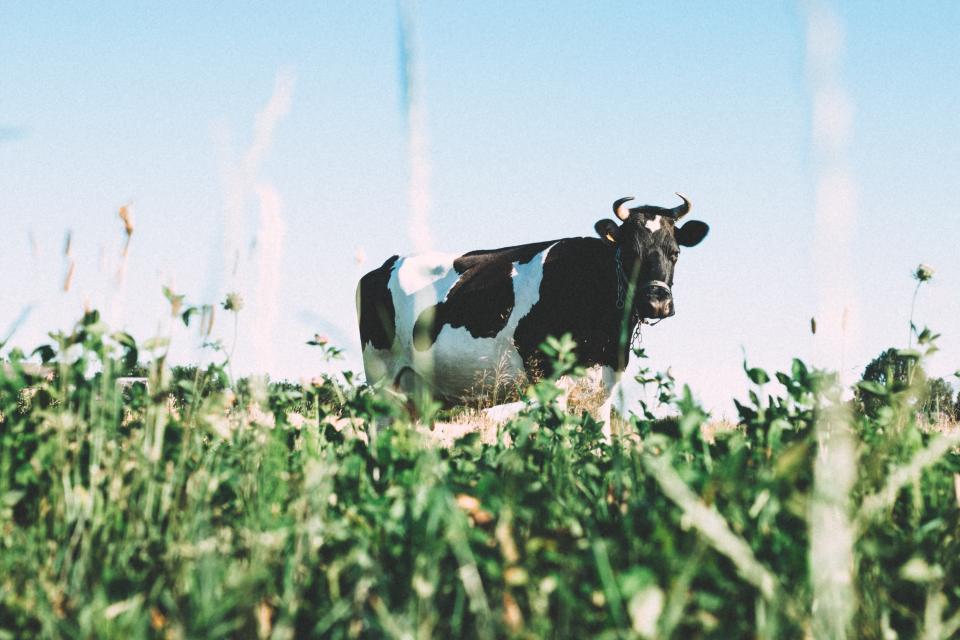Have you ever watched your feline friend munch on a blade of grass with an air of pure contentment? While it may seem peculiar, cats eating grass is a common behaviour, and one that has puzzled owners for centuries. Understanding the reasons behind this seemingly unusual craving can provide valuable insight into your cat's well-being and dietary needs. This article will delve into the various theories surrounding feline grass consumption, exploring the potential benefits and risks, and offering practical advice to satisfy your cat's grass cravings in a safe and enriching way.
Part 1: The Mystery of Feline Grass Craving

1.1 A Natural Instinct?
- Evolutionary Theories: Some theories suggest that cats' grass-eating habit is a remnant of their wild ancestors, who may have consumed grass to aid digestion or to expel parasites. While domestic cats no longer need to hunt for their food, this instinctual behaviour persists, potentially driven by the same underlying reasons.
- Nutritional Benefits: While cats are obligate carnivores, meaning they primarily need animal-based protein, grass might provide a source of essential vitamins, minerals, and fibre that their meat-based diet lacks. For example, grass contains folic acid, which is important for red blood cell production, and vitamin A, which is crucial for vision and immune function.
1.2 The Role of Fibre
- Indigestion Relief: Cats' digestive systems are not as efficient as those of herbivores, and they may struggle to digest certain types of food, especially if their diet is high in processed ingredients. Grass can act as a natural laxative, helping to move indigestible material through the digestive tract and relieve constipation. The rough texture of the grass helps to stimulate peristalsis, the wave-like muscular contractions that move food through the gut.
- Hairball Prevention: As meticulous groomers, cats often ingest hair during their self-grooming sessions. This can lead to hairballs, which can cause discomfort and even blockages in the digestive tract. The rough texture of grass can help to dislodge hairballs from the digestive tract, preventing potential blockages. The grass fibres also bind to the hairballs, making them easier to pass.
1.3 Grass as a Source of Nutrients
- Vitamin Deficiencies: While cat food is typically formulated to provide all the necessary nutrients, some cats might have specific nutritional needs that are not fully met by their diet, especially if they are fed a low-quality food. Grass can provide a source of vitamins and minerals, such as vitamin A, vitamin E, and folic acid, which might be lacking in their diet.
- Enrichment and Boredom: Cats are naturally curious and playful animals. For some cats, grass-eating can be a form of enrichment, providing a stimulating sensory experience. It can also be a way to alleviate boredom, especially for indoor cats with limited outdoor access. The act of chewing and nibbling on grass can provide mental and physical stimulation, keeping cats engaged and entertained.
Part 2: The Risks Associated with Grass Consumption

2.1 Toxic Plants
- Careful Selection: It is crucial to ensure that the grass your cat is eating is safe and non-toxic. Avoid toxic plants, such as lilies, daffodils, and azaleas, which can cause serious health problems in cats. Ingesting these plants can lead to vomiting, diarrhea, kidney failure, and even death in some cases. Always research the potential toxicity of any plants your cat might have access to.
- Indoor Grass Solutions: Consider providing your cat with a safe and designated area for grass consumption, such as a pot of cat grass or a commercially available grass mat. This way, you can control the type of grass they eat and minimize the risk of them ingesting harmful plants. Indoor grass solutions also prevent your cat from digging up your garden or damaging your houseplants.
2.2 Pesticides and Herbicides
- Contamination Concerns: If your cat has access to outdoor grass, it is vital to be aware of potential contamination from pesticides and herbicides. These chemicals can be highly toxic to cats and can cause a range of symptoms, including vomiting, diarrhea, lethargy, and even neurological problems. Even small amounts of pesticide residue can be dangerous for cats.
- Organic Options: Choose organic grass or lawn care practices that avoid the use of pesticides and herbicides. This will ensure that your cat is consuming safe and healthy grass. Consider using natural pest control methods like diatomaceous earth or introducing beneficial insects to your garden.
2.3 Parasites and Infections
- Parasite Transmission: Grass can be a breeding ground for various parasites, such as roundworms, tapeworms, and fleas. These parasites can be transmitted to cats through ingestion or skin contact. Roundworms, for example, can be ingested by cats when they eat grass contaminated with infected faeces.
- Prevention Measures: Regularly de-worm your cat and use flea control products to minimize the risk of parasite infection. If your cat eats outdoor grass, consider washing it with a mild detergent and water to remove any potential contaminants. Keep your cat's living environment clean and free of parasites.
Part 3: Providing Safe and Enriching Grass Options

3.1 Cat Grass: A Safe and Nutritious Option
- Types of Cat Grass: Common cat grass varieties include wheatgrass, oat grass, and barley grass. These grasses are specifically grown for feline consumption and are typically safe and nutritious. They are also relatively easy to digest, making them ideal for cats.
- Easy to Grow: Cat grass is relatively easy to grow at home. You can purchase seeds or kits online or at pet stores and grow your own fresh grass for your cat to enjoy. Growing your own cat grass is also a cost-effective way to provide your cat with a constant supply.
- Benefits of Different Varieties: Wheatgrass is known for its high levels of chlorophyll, vitamins, and minerals. Oat grass is a good source of fibre and is said to aid digestion. Barley grass is rich in antioxidants and can help boost the immune system.
3.2 Commercial Grass Mats
- Convenience and Safety: Commercial grass mats offer a convenient and safe alternative to outdoor grass. They are typically made of a blend of safe grasses and are pre-sprouted, so they are ready to use right out of the package. This eliminates the need for you to grow your own cat grass, saving you time and effort.
- Variety of Options: Grass mats come in various sizes and styles, making them suitable for cats of all ages and sizes. They can be placed in a variety of locations, such as on the floor, windowsill, or cat tree. Look for mats that are made with non-toxic materials and are free of pesticides and herbicides.
3.3 Enriching Your Cat's Environment
- Variety and Stimulation: By providing your cat with a variety of grass options, you can ensure they stay interested and stimulated. Rotate different types of grass and encourage them to explore different textures and flavours. You can also try planting different types of herbs, such as catnip or thyme, which cats often enjoy.
- Play and Interaction: Include grass as part of your cat's playtime. Plant grass in a pot on a cat tree or scatter grass on the floor to encourage your cat to explore and play. You can also create a fun and engaging environment by setting up a "grass garden" with different pots and trays of grass.
Part 4: When to Consult a Veterinarian
- Excessive Grass Eating: If your cat is eating an excessive amount of grass, it might be a sign of an underlying medical condition, such as digestive issues, nutrient deficiencies, or parasites. If you notice your cat eating an unusually large amount of grass or if they are constantly seeking it out, it's important to consult your veterinarian.
- Changes in Behaviour: Pay attention to any changes in your cat's behaviour, such as vomiting, diarrhea, lethargy, or weight loss. These symptoms could indicate a health problem and require veterinary attention. If your cat is vomiting frequently after eating grass, or if they are exhibiting other signs of illness, it's essential to seek veterinary care.
- Unusual Symptoms: If your cat exhibits any unusual symptoms after eating grass, such as seizures, tremors, or difficulty breathing, seek emergency veterinary care immediately. These symptoms could indicate a serious reaction to a toxic plant or a severe allergic reaction.
Part 5: FAQs
5.1 Is it normal for cats to eat grass?
Yes, it is a common behaviour among cats and there are various reasons why they might do it. It's often a natural instinct, a way to aid digestion, and potentially a source of nutrients. However, it's important to ensure that your cat is eating safe grass and to monitor their behaviour for any signs of distress.
5.2 What kind of grass is safe for cats?
Cat grass varieties, such as wheatgrass, oat grass, and barley grass, are generally considered safe. Avoid toxic plants like lilies, daffodils, and azaleas. Always research the specific toxicity of any plants you are unsure about.
5.3 Should I be worried if my cat eats a lot of grass?
While moderate grass consumption is usually harmless, excessive grass eating might indicate an underlying medical condition. Consult your vet if you notice any changes in your cat's behaviour or appetite. Keep a record of how much grass your cat eats and any changes in their eating habits.
5.4 Can I grow my own cat grass?
Yes, growing cat grass is relatively easy. You can purchase seeds or kits online or at pet stores and grow it in a pot or tray. Ensure the soil you use is free of pesticides and herbicides.
5.5 How can I encourage my cat to eat grass?
Place a pot of cat grass in a prominent location, or sprinkle a bit of grass on their food bowl. Encourage playful exploration around the grass to stimulate their interest. You can also introduce the grass gradually, starting with small amounts and gradually increasing the quantity as your cat becomes accustomed to it.
5.6 Is it okay to let my cat eat outdoor grass?
While it's possible, be aware of potential contamination from pesticides, herbicides, and parasites. If you do allow them to eat outdoor grass, ensure it's safe and free of contaminants. It's best to avoid letting your cat eat grass from areas that have been treated with pesticides or herbicides.
5.7 What should I do if my cat vomits after eating grass?
Vomiting after eating grass is a normal reaction for cats, as it can help them expel any indigestible material. However, if the vomiting is frequent, excessive, or accompanied by other symptoms, consult your veterinarian. Keep an eye on your cat's behaviour and seek veterinary advice if you have any concerns.
5.8 How often should I give my cat grass?
There's no specific frequency, but offering a fresh supply of cat grass regularly can encourage them to eat it and provide a source of nutrients and fibre. You can replenish the grass supply every few days or as needed. Monitor your cat's intake and adjust the frequency based on their individual preferences.
Remember, cats are curious creatures with unique personalities and dietary needs. By understanding the reasons behind their grass-eating habits, you can provide a safe and enriching environment for your furry friend, ensuring they stay healthy and happy.
Everyone is watching

Are Cat Ribs Flexible? Understanding Their Anatomy
CATS & KITTENSThis article delves into the fascinating world of feline anatomy, exploring the flexibility of cat ribs and ho...

Can Cats Eat Bananas? (Everything You Need to Know)
CATS & KITTENSThis article dives into the intriguing question of whether cats can safely enjoy the sweet, yellow fruit, bana...

Cat Lifespan: How Long Do Cats Live?
CATS & KITTENSThis comprehensive guide explores the factors influencing the lifespan of our feline companions, providing ins...

Can Cats Get COVID-19? What You Need to Know
CATS & KITTENSThis article will delve into the fascinating world of feline COVID-19 susceptibility. We'll explore whether ca...

Can Cats Eat Eggs? A Complete Guide to Egg Safety for Your Feline Friend
CATS & KITTENSWhen it comes to treating our furry companions, we all want to ensure we're doing what's best for them. Eggs...
